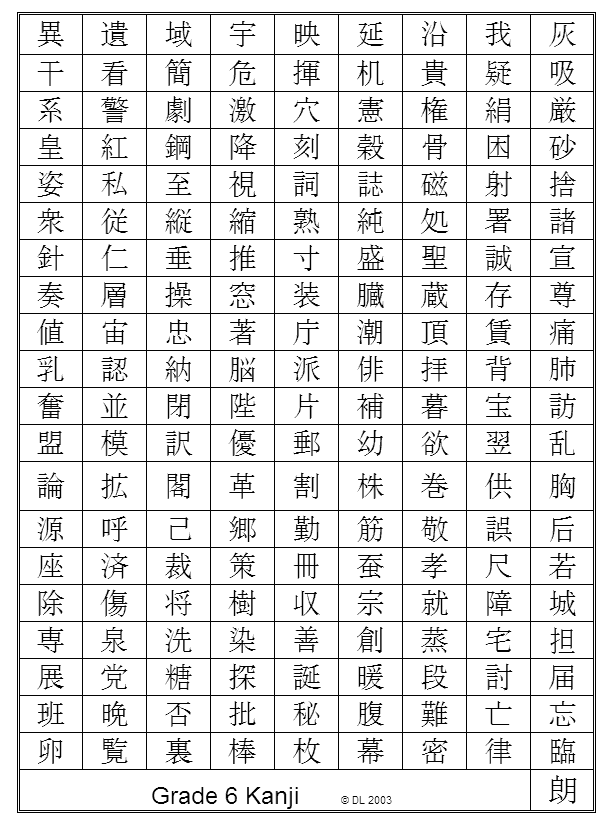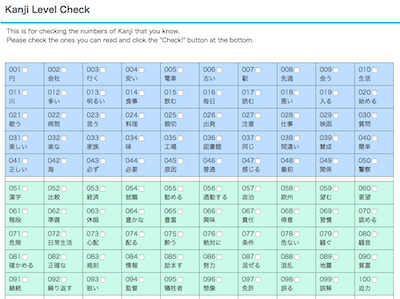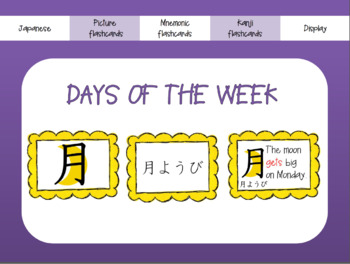TRANSCRIPT


- 1.THE FIRST 103 KANJI



N5 Kanji List Pdf
Apr 27, 2018 Kanji learning books List of 1000 Kanji (PDF – free download) – from thejapanesepage. DEMO You may also like Related. The new list is currently said to have removed 5 kanji and added new ones,. The jouyou kanji list is the sum of all the characters taught in. This list contains all Kanji in the revised Jōyō Kanji list. This is a guide to the Kanji characters by the Japanese Ministry of Education. If you want to be able.
Jlpt N5 Kanji List Pdf
2. About this book This book helps beginners of the Japanese language memorizing and writing the first 103 kanji characters required for the Japanese Language Proficiency Test N5. Each kanji is represented on one page featuring: Its meaning The onyomi and kunyomi readings Vocabulary that includes this kanji The number of strokes and the stroke order with a link to the NIHONGO ICHIBAN website to video showing the stroke order The radicals (components) the kanji consists of A hint to help memorizing the kanji A grid to exercise writing You can print each page on your own printer and repeat the writing exercises as often as you like. 3. Copyright This book is a service to the community of Japan fans. THERE IS NO COPYRIGHT! Please feel free to share it with your friends and other students of Japanese. About us NIHON ICHIBAN is a social business to promote Japanese culture and lifestyle in the world. With our free websites we serve a community of more than 92,000 fans of Japan in more than 150 countries. The NIHON ICHIBAN SHOP is the leading online shop for authentic Japanese craft, design and food products. Please visit our shop first when you need something from Japan. NIHONGO ICHIBAN: http://nihongoichiban.com NIHON ICHIBAN: http://nihon-ichiban.com JAPAN BLOG DIRECTORY: http://japanblogdirectory.com NIHON ICHIBAN SHOP: http://anything-from-japan.com 4. The Japanese writing system The Japanese written language consists of a combination of three types of characters. To a lesser extend it nowadays also uses some Latin alphabet for abbreviations and numbers. 1) Kanji () Kanji originally came from China to Japan. The term kanji literally means Han characters or Chinese characters and it is identical to the characters in China to describe their writing. Kanji are mainly used to describe names and nouns. When used in verbs and adjectives they mostly are written in combination with hiragana. Most sentences include kanji as well as hiragana. Japanese dictionaries list around 10,000 kanji. The Japanese government limited the kanji used in ofcial publications to the 1945 touyou kanji with about 4000 readings. The Japanese Language Prociency Test (JLPT) is based on these 1945 touyou kanji. A Japanese with average education knows around 3000 kanji and it is estimated that around 4000 kanji are used in Japanese literature. 2) Hiragana () Hiragana is a phonetic alphabet that was developed in the ninth century to simplify writing. It nowadays is mainly used for native Japanese words. Hiragana are derived from more complex kanji and each hiragana represents a syllable. A total of 46 hiragana are used in contemporary Japanese writing. List of the 46 hiragana and their 25 diagritics (with or ) A I U E O (a) (i) (u) (e) (o) (ka) (ga) (ki) (gi) (ku) (gu) (ke) (ge) (ko) (go) (sa) (za) (shi) (ji) (su) (zu) (se) (ze) (so) (zo) (ta) (da) (chi) (ji) (tsu) (zu) (te) (de) (to) (do) (na) (ni) (nu) (ne) (no) 5. A I U E O (ha) (ba) (pa) (hi) (bi) (pi) (fu) (bu) (pu) (he) (be) (pe) (ho) (bo) (po) (ma) (mi) (mu) (me) (mo) (ya) (yu) (yo) (ra) (ri) (ru) (re) (ro) (wa) (o/wo) (n) The combination of some of these hiragana is used to express a few additional sounds used in Japanese. The rst character is written in normal size whereas the second character is written a little bit smaller. These combinations are called digraphs. List of 21 hiragana digraphs and their 15 diagritics YA YU YO (kya) (gya) (kyu) (gyu) (kyo) (gyo) (sha) (ja) (shu) (ju) (sho) (jo) (cha) (ja) (chu) (ju) (cho) (jo) (nya) (nyu) (nyo) (hya) (bya) (pya) (hyu) (byu) (pyu) (hyo) (byo) (pyo) (mya) (myu) (myo) (rya) (ryu) (ryo) 3) Katakana () Katakana also is a phonetic alphabet covering the same syllable as hiragana and it therefore also has 46 different characters. It is mainly used for foreign loanwords and sometimes to replace kanji or hiragana for emphasis. Katakana were developed in the ninth century and are also derived from more complex kanji. 6. List of the 46 basic katakana and their 25 diagritics (with or ) A I U E O (a) (i) (u) (e) (o) (ka) (ga) (ki) (gi) (ku) (gu) (ke) (ge) (ko) (go) (sa) (za) (shi) (ji) (su) (zu) (se) (ze) (so) (zo) (ta) (da) (chi) (ji) (tsu) (zu) (te) (de) (to) (do) (na) (ni) (nu) (ne) (no) (ha) (ba) (pa) (hi) (bi) (pi) (fu) (bu) (pu) (he) (be) pe) (ho) (bo) (po) (ma) (mi) (mu) (me) (mo) (ya) (yu) (yo) (ra) (ri) (ru) (re) (ro) (wa) (o/wo) (n) As with hiragana there also are combinations to express the other sounds required for the Japanese language. List of 21 katakana digraphs and their 15 diagritics YA YU YO (kya) (gya) (kyu) (gyu) (kyo) (gyo) (sha) (ja) (shu) (ju) (sho) (jo) (cha) (ja) (chu) (ju) (cho) (jo) (nya) (nyu) (nyo) 7. YA YU YO (hya) (bya) (pya) (hyu) (byu) (pyu) (hyo) (byo) (pyo) (mya) (myu) (myo) (rya) (ryu) (ryo) These 46 katakana and their variations are sufcient to express all sounds used for Japanese words. In order to get closer to the pronunciation of foreign words, a list of not so common extended katakana is used. List of extended katakana A I U E O (yi) (ye) (wa) (wi) (wu) (we) (wo) (va) (vi) (vu) (ve) (vo) (vye) (kye) (gye) (kwa) (kwi) (kwe) (kwo) (gwa) (gwi) (gwe) (gwo) (she) (je) (si) (zi) (che) (tsa) (tsi) (tse) (tso) (ti) (tu) (di) (du) (nye) (hye) (bye) 8. A I U E O (pye) (fa) () (fe) (fo) (fye) (hu) (mye) (rye) (la) (li) (lu) (le) (lo) 4) Writing a Japanese text It is possible to write everything in hiragana or katakana since both scripts cover the entity of sounds of the Japanese language, although this is not very practical due to the high number of words having the same pronunciation but different meanings. All characters are written one by one and in the same size. There are no spaces between different words, which feels a little bit unusual for most foreigners. It takes time to get used to this and easily distinguish different words. It is important to write the strokes in the correct order and directions to give the characters the right shape. The reason why becomes obvious when practicing with a brush pen1, which is very much recommended for beginners. Japanese writing is made in two directions. Horizontal writing (yokogaki) is from the left to the right as in western style. Traditional writing (tategaki) is vertical starting from the right top and ending at the left bottom. A book printed in tategaki opens from what Westerners would call the back, while a book printed in yokogaki opens from what traditionally in Japan would have been considered the back.2 1 A brush pen is a pen with a brush instead of a brush instead of the nib. You can get them in some Japanese shops or via mail order. 2 Wikipedia, Japanese writing system 9. Meaning: One Onyomi: Ichi / Itsu [/] Kunyomi: Hito [] Vocabulary: - - hitokuchi - One bite is just one stroke 1 stroke 10. Meaning: Two Onyomi: Ni [] Kunyomi: Futa [] Vocabulary: - - futari - Two persons is made of two strokes + = 1 + 1 = 22 strokes 11. 3 strokes Meaning: Three Onyomi: San [] Kunyomi: Mitsu / Mi- [/] Vocabulary: 3 - - mikka - The 3rd is the result of + 1 + 2 = 3 12. Meaning: Four Onyomi: Shi [] Kunyomi: Yo / Yu / Yon [//] Vocabulary: - - shiki - The 4 seasons There are four sides to a square 5 strokes 13. Meaning: Five Onyomi: Go [] Kunyomi: Itsu [] Vocabulary: - - itsutsu - Five (ordinal number) It looks like the number 5 4 strokes 14. Meaning: Six Onyomi: Roku [] Kunyomi: Mu/Mut/Mui [//] Vocabulary: - - muttsu - Six (ordinal number) 6 can be written VI if you turn them around you get 4 strokes 15. Meaning: Seven Onyomi: Shichi [] Kunyomi: Nana/Nano [/] Vocabulary: shichigatsu - July It is a 7 inverted 2 strokes 16. Meaning: Eight Onyomi: Hachi [] Kunyomi: Yat/Ya/You [//] Vocabulary: - - Yattsu Eight (ordinal number) When following the simple shape of the 8 you get 2 strokes 17. Meaning: Nine Onyomi: Kyuu/Ku [/] Kunyomi: Kokono [] Vocabulary: - - Kokonoka - The 9th You can see the shape of a 9 with a little imagination 2 strokes 18. Meaning: Ten Onyomi: Juu/Ji [/] Kunyomi: Too [] Vocabulary: - - Tooka The 10th 10 can be written X 2 strokes 19. Meaning: Hundred Onyomi: Hyaku [] Kunyomi: / Vocabulary: - - Hyakkaten - A mall 100 ->6 strokes I00 20. Meaning: Thousand Onyomi: Sen [] Kunyomi: Chi [] Vocabulary: - - nisenen - Two thousand Yen Thousand starts with the letter T 3 strokes 21. Meaning: Ten thousand Onyomi: Man/Ban [/] Kunyomi: / Vocabulary: - - manbiki Shoplifting It looks like a capital T and a h combined like in Thousand and the capital T also stands for Ten3 strokes 22. Meaning: Water Onyomi: Sui [] Kunyomi: Mizu [] Vocabulary: - - suidou - Water pipe It can represent the current of water 4 strokes 23. Meaning: Fire Onyomi: Ka [] Kunyomi: Hi [] Vocabulary: - - kazan Volcano It looks like a camp fire with flames flying around. 4 strokes 24. Meaning: Tree, wood Onyomi: Boku/Moku [/] Kunyomi: Ki/Ko [/] Vocabulary: - - mokuyoubi Thursday It is easy to remember since it looks like a tree ! 4 strokes 25. Meaning: Sky Onyomi: Ten [] Kunyomi: Ame, Ama [/] Vocabulary: - - tenki Weather Heaven is one () big () place ! 4 strokes 26. Meaning: Earth, Ground Onyomi: : Do / To [/] Kunyomi: Tsuchi [] Vocabulary: - - tsuchi Earth It looks like a cross on a grave buried in the ground 3 strokes 27. Meaning: North Onyomi: Hoku [] Kunyomi: Kita [] Vocabulary: - - hokubei - North America When putting it together it looks like a ladder to go up NORTH 5 strokes 28. Meaning: East Onyomi: Tou [] Kunyomi: Higashi [] Vocabulary: - - toukyou - Tokyo The sun () rise behind a tree () on the East. 8 strokes 29. Meaning: West Onyomi: Sei /Sai [/] Kunyomi: Nishi [] Vocabulary: - - seirek